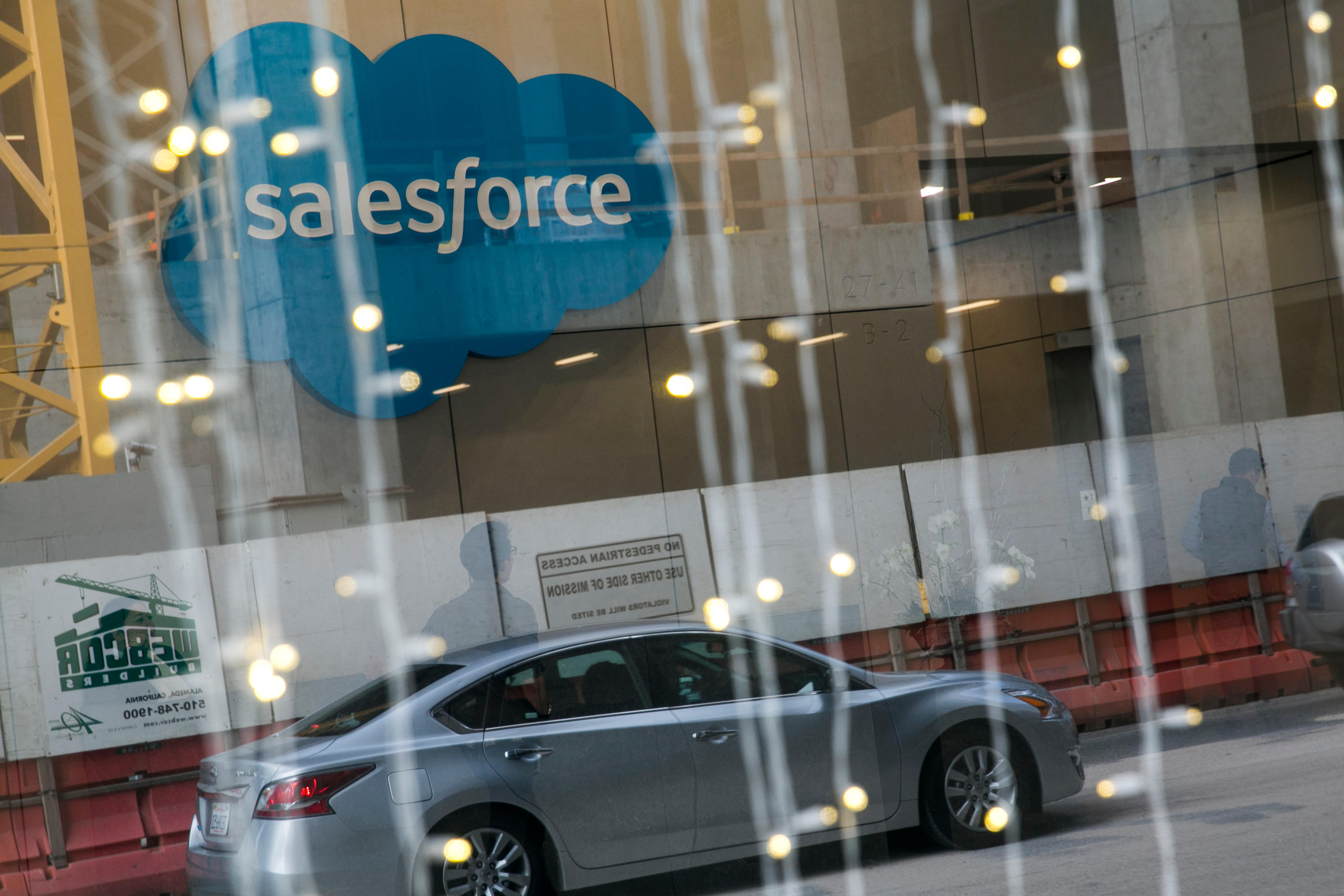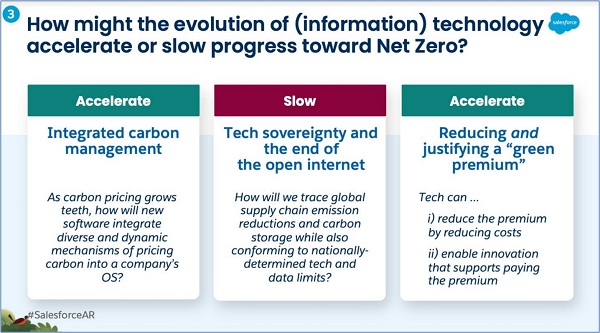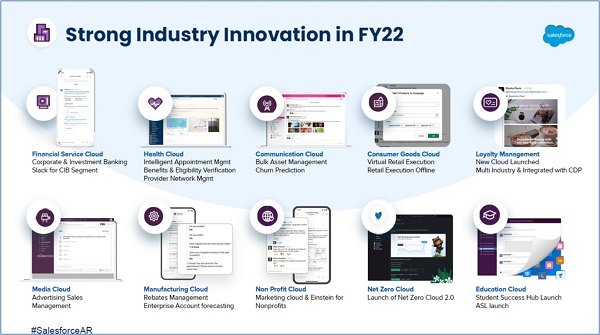Salesforce held its first in-person industry analyst summit in over three years last week at Salesforce Tower in San Francisco. Salesforce had transitioned to virtual analyst forums at the start of the pandemic in 2020, and held 12 virtual forums between then and now. But it was great to return to an opportunity to mix and mingle “in real life.”
The company and approximately 45 analysts (who chose to attend in an environment where many remain cautious) were thrilled with the in-real-life interaction with Salesforce senior leadership and the thoughtfully curated content.
Core Values
Some themes recurred throughout a half-day of one-on-one sessions and a (very) full day of presentations. These themes are always tied back to Salesforce’s core values of trust, customer success, innovation, equality, and sustainability.
Sustainability is relatively new to Salesforce’s list of core values, having been
added just two months ago. Now that Salesforce has reached net zero emissions, the company wants to use its technology and best practices to help its customers reach their climate goals. One example is Salesforce Net Zero Cloud 2.0, a solution that tracks greenhouse gas emissions, available globally.
At the analyst summit, several speakers added additional color to Salesforce’s sustainability efforts.
Bret Taylor, co-CEO of Salesforce, commented that over the past month, he has met with tens of CEOs of companies across the US. In every one of those conversations, ESG was a topic of conversation. (ESG means using environmental, social, and governance factors to evaluate companies and countries on how far advanced they are with sustainability.) Particularly compelling was the discussion by
Michael Costigan, vice president Salesforce Futures. Costigan is part of an organization led by futurist
Peter Schwartz, who joined Salesforce in 2011. The organization performs what they call scenario-planning, a process of identifying the most likely outcomes for the future and helping businesses and governments prepare.
As an example of a scenario Salesforce Futures identified and planned, Costigan discussed how information technology might accelerate or slow progress toward net zero.
Identifying future scenarios and outcomes can help Salesforce and its customers plan no only how to take greater advantage of positive outcomes but work to ameliorate negative ones.
Digital Transformation and Agility
Digital transformation is not a new topic, but it is one that changes with macro conditions. The slide above used by
David Schmaier, Salesforce president & chief product officer, highlights how enterprise executives’ thinking around digital transformation is currently focused on cost reduction. It also shows how the digital transformation focus may shift in two years to gaps in execution. The logic is if companies can think ahead as they deploy the technology today, perhaps they can avoid downstream execution gaps.
Salesforce executives pointed out that no organization wants to be caught flat-footed. When there is a disruption of the scale of the pandemic, or even right now—with what is going on with the supply chain, inflation, wage inflation, and disruption to the global economy because of the war in Ukraine—the theme that has emerged is agility.
Why is agility a key component of digital transformation? Companies now have a better understanding that if, for example, you have a two-year project with a big deliverable at the end, the whole world is going to change in those two years. Conversations with executives today are about the technology platforms that can be put in place to position a company to have the agility to respond to those inevitable changes.
Industry Clouds
When I began my career at AT&T in 1981, the sales force was organized into nine industry groupings. It was not only a sales and marketing focus, but specific solutions were developed for specific verticals. Case-in-point, I was assigned to the retail line of business because I had work experience at a major department store. During my years supporting the Lord and Taylor account, AT&T’ developed automated bridal registry for the retail sector, which coordinated registries at stores across the country – something we take for granted now.
Over the years, I have seen the fashion for industry specialization come and go, but cloud-based industry solutions are definitely “having a moment.” Salesforce was an early mover bringing industry specialization to cloud software, beginning with Salesforce Health Cloud in 2016. As discussed at last week’s meeting, the company doubled down on its commitment to industries with the $1.33 billion
acquisition of Vlocity, a provider of industry-specific solutions built natively on the Salesforce Platform, 2021.
With the founder and CEO of Vlocity, Schmaier, now CPO, Salesforce continues vertical specialization through its twelve industry clouds. Each of these clouds and associated industry solutions—shown in the graphic below—are regularly updated with new functionality and tighter integration to existing and new Salesforce components, for example Slack. In addition, new products are launched on a regular basis, such as
Loyalty Management in Salesforce fiscal year 2022, described as a cross-industry product. Existing clouds are also re-launched, like Sustainability Cloud as Net Zero Cloud, after being completely rebuilt with trusted reporting, deeper insights, and supplier management.
Analysts wanted to know more about Salesforce’s approach to industry clouds versus “core” Salesforce solutions, e.g., Service Cloud, Sales Cloud, and Marketing Cloud.
David Schmaier, president, chief product officer, Salesforce, summarized the logic and appeal of industry clouds with these comments. “What could be faster than financial services software designed for financial services companies? What could be faster a path to digital transformation if you are a healthcare company than Health Cloud, designed with the fields of information displayed specific to the workflow of your business?”
While no specific numbers were given, Jujhar Singh, EVP and general manager industries, Salesforce, offered that new Salesforce customers increasingly begin with an industry-specific solution. Also, existing customers of Service and Sales Cloud have shown interest in moving to industry clouds. Salesforce has created both commercial and product migration paths to facilitate these moves for customers.
The final speaker of the day was Amy Weaver, president, CFO, Salesforce. While at some firms this can be the driest of content, Weaver did honor her surname with how skillfully she spun fact-based tales of Salesforce’s financial success intricately woven with Salesforce’s core value commitments. As did all the speakers, she left us with the inspiring sense that at Salesforce doing good in the world is as important an everyday goal as doing well financially as a company.














